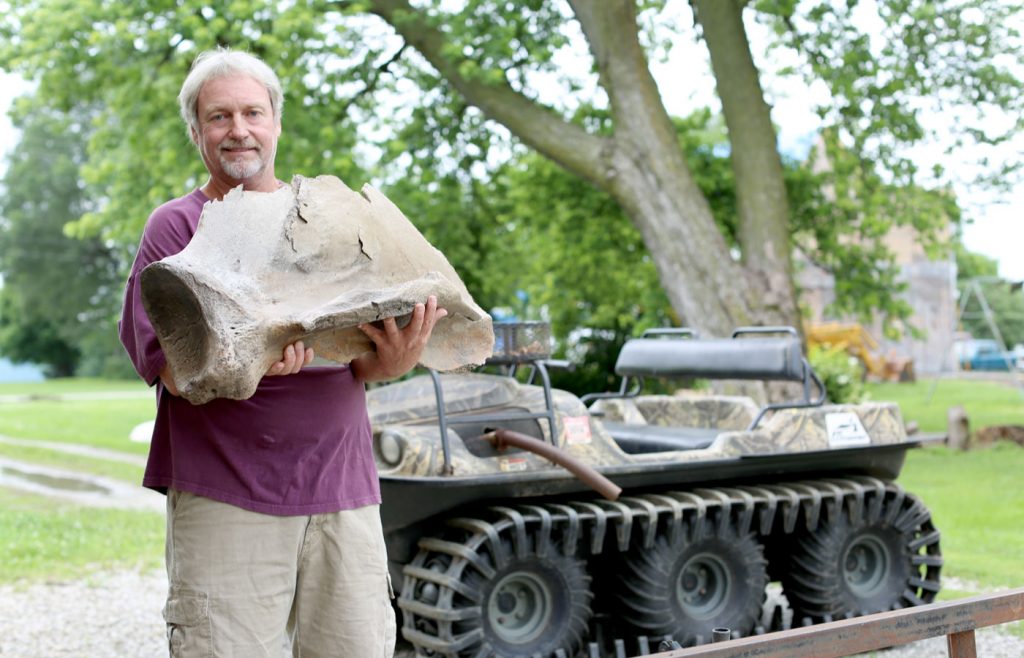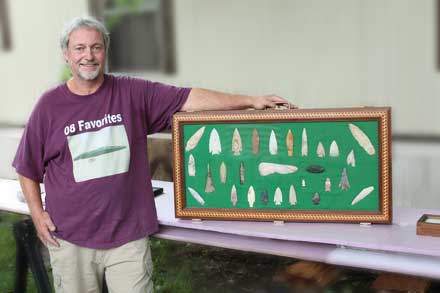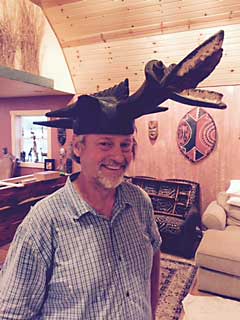
Rain pummels the vast tracts of cornfields surrounding Gary Nelson’s home in tiny Birmingham, Iowa. The blurred flat fields roll on as far as the eye can see, mingling with distant woods and creeks that Nelson experiences in a far different way than do most of the farmers and townspeople around here: through the eyes of the prehistoric Sauk and Fox Indians who had inhabited these lands for millennia.
Nelson has scooped up some 4,000 of their arrowheads, 200 axes, and 10 “Holy Grail pieces,” as he calls them, over 35 years as an artifact hunter. He has nabbed rare Clovis spear tips and a woolly mammoth tooth, items worth thousands of dollars to collectors. A few of Nelson’s finds date back 13,500 years.
Sitting at his kitchen table, Nelson is telling me he receives messages in his dreams. Ancient hunters appear to him and direct him to specific locations where he can find their tools and weapons. He senses “power” in the artifacts. “You can really feel it when you touch this stuff,” he says.

Nelson has walked through most of the fields and streams of Van Buren County, nearly always finding booty. In June 2008, when heavy rain flooded the rivers and brought the banks up, he collected an astonishing 175 arrowheads in a single day. “I’ve hunted most everything out of here,” he says. “I’ve deleted all these fields.”
He keeps the most valuable pieces for himself, selling arrowheads from his roadside thrift shop next door.
At 53, Gary Nelson often sounds like an excitable boy—albeit a heavily stubble-cheeked one—as he recounts his tales of discovery, which gush out, wind this way and that, and meander and surge in often surprising directions, covering many thousands of miles in footsteps in a county of 500 square miles.
But the physical effort required has taken its toll. “I feel like I’ve got the body of a 98-year-old,” Nelson laments, and recent experience has borne him out.
As he was prepping for this interview, laying out his display cases of mounted arrowheads and Prehistoric American magazines opened up to articles that feature him (one showing a pictorial spread of his prize 4,000-year-old Keokuk slant groove axe), his anxious excitement got the best of him. He felt a painful pinching in his chest. A trip to Van Buren County Hospital revealed a heart murmur. “When I bring this stuff out it really amps me up,” he explains. (He has since gotten a cautionary but clean bill of health.)
Nelson’s new two-story home, which he designed himself, is just a stone’s throw from Birmingham’s lone traffic signal. The town is one square mile with a population of 441.
With its vaulted ceilings built of knotty pine by local Amish, the spacious house has the woodsy feel of a lodge. Nelson’s varied passions are amply on display on walls and tabletops. They include a Pleistocene-period musk ox skull, a woolly mammoth scapula, a mounted deer head, ceremonial African masks, a shark’s jaw, a mounted three-foot-long Asian Carp, and an Amazon rainforest alligator hat. Somehow, too, there’s a replica Stradivarius violin. In the loft at the top of a spiral staircase is Nelson’s igloo-shaped bedroom he constructed out of hog panels.
A stem-winder accompanies all of Nelson’s artifacts, which he eagerly tells, seamlessly switching from one story to the next when necessary to make a point. He pauses in mid-sentence to point out an odd-looking rock-like object on a nearby table. “When I saw that, well, it was either a mammoth tooth or a Walmart tennis shoe,” he laughs.

In the center of the room is a regulation-height basketball backboard and hoop on a 10-foot pole, though it’s hard to imagine Nelson shooting free throws in here. “I just … like it,” he says with a shrug. Nelson’s uniqueness is on display everywhere in the fascinating man-cave, which could pass for a small museum, or maybe Indiana Jones’s den.
Gary Nelson grew up in Fairfield, Iowa, 12 miles north, moving with his family to Van Buren County when he was 11. Watching his dad pick up arrowheads and send them skipping over a local pond spawned Nelson’s obsession. His first hunt took him through fields of waist-high soybeans into rocky washouts where he found arrowheads and axe heads laying in the grass for the picking. “I took them and showed them to my dad,” he recalls.
After one of his revelatory dreams, Nelson will load his Argo six-wheel amphibious craft onto his flat-bed truck and drive out on the hunt. “I find them just like they appeared to me,” he says. He often videotapes his river walks and uploads the POV footage, along with commentary, onto his YouTube channel.
Right now he’s gripping a massive woolly mammoth scapula. His face brightens suddenly. “I know why I got the palpitations,” he says. Every phenomenon hides a deeper truth, and this one is about his friend Rob Taylor, who died not long ago suddenly of a heart attack. Nelson explains that the close friendship had “extended” the ailment to himself.
Maybe so. One never knows. Personally, at the moment, I’m caught up in imagining a day that begins with a dream-time dialogue with a 4,000-year-old Indian and ends with a YouTube video.
To Gary Nelson, it all makes perfect sense. This Iowa life of his, in which he works as a house painter from Monday to Saturday, topped by that precious adventure day at the end—this life that could have been routine and predictable, Nelson has infused with travel to other times and meetings with ancient peoples.
Just as in that older Iowa, when Chief Keokuk and his men trekked amid the prairie grasses, Gary Nelson has found his own means of adventure. When he’s not hunting, or painting, or making wine or riding his motorcycles, Nelson may be attempting to divine the meaning of the notches on a Gorget pendant, those minute tally marks spaced exactly 1/16th of an inch apart, whose purpose continues to stump archeologists. (The answer came to him in a dream: “It’s a calendar.”)
When he’s out in the fields, Nelson travels back in time to a land that’s strikingly at odds with the tilled, uniform tabletop of industrial corn and soybean farms that now stretch on and on.
We can only hope that, going forward, Gary Nelson will be able to tamp down his excitement to manageable, healthier levels, for more Holy Grail finds may be waiting for him. “I most want to find the claw of a three-toed sloth,” he says with a real hunger in his voice. “The ultimate would be a woolly mammoth shoulder blade with a Clovis point still stuck in it.”
I nod, sensing his strong desire. Perhaps he’ll succeed at finding those things. Maybe the precise location will announce itself in the wee hours one morning as a whisper from a long-ago hunter. After spending some time with Gary Nelson, one can believe it.
Contact writer:
info@warrengoldie.com
www.WarrenGoldie.com
